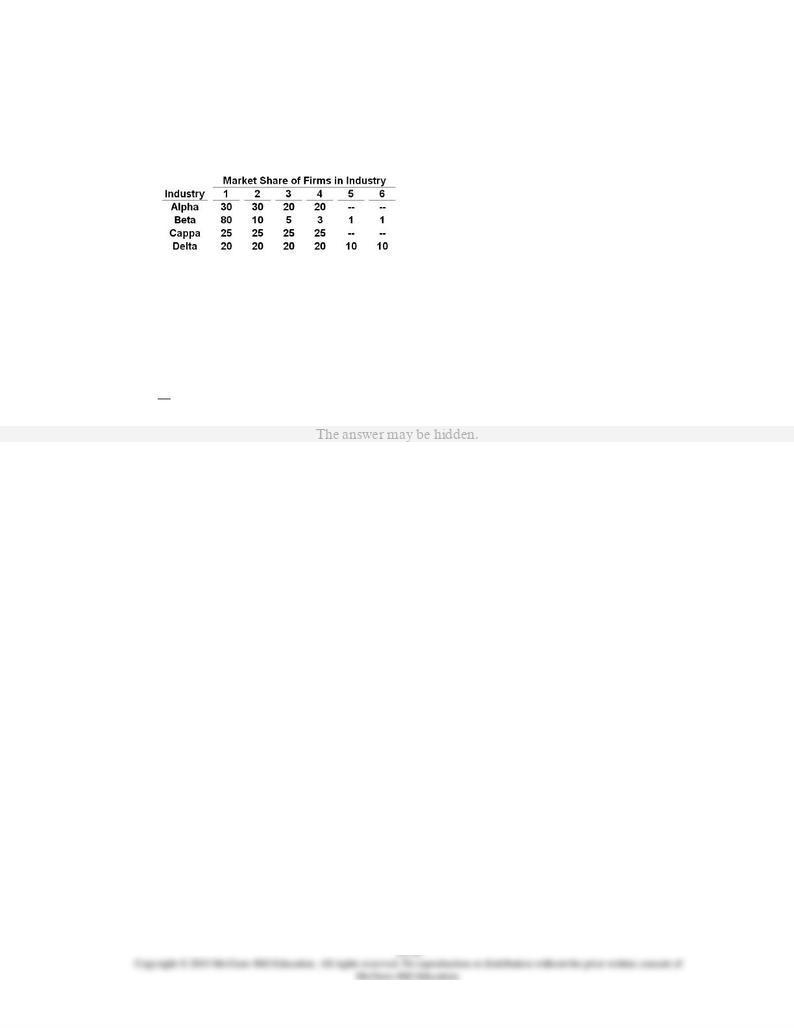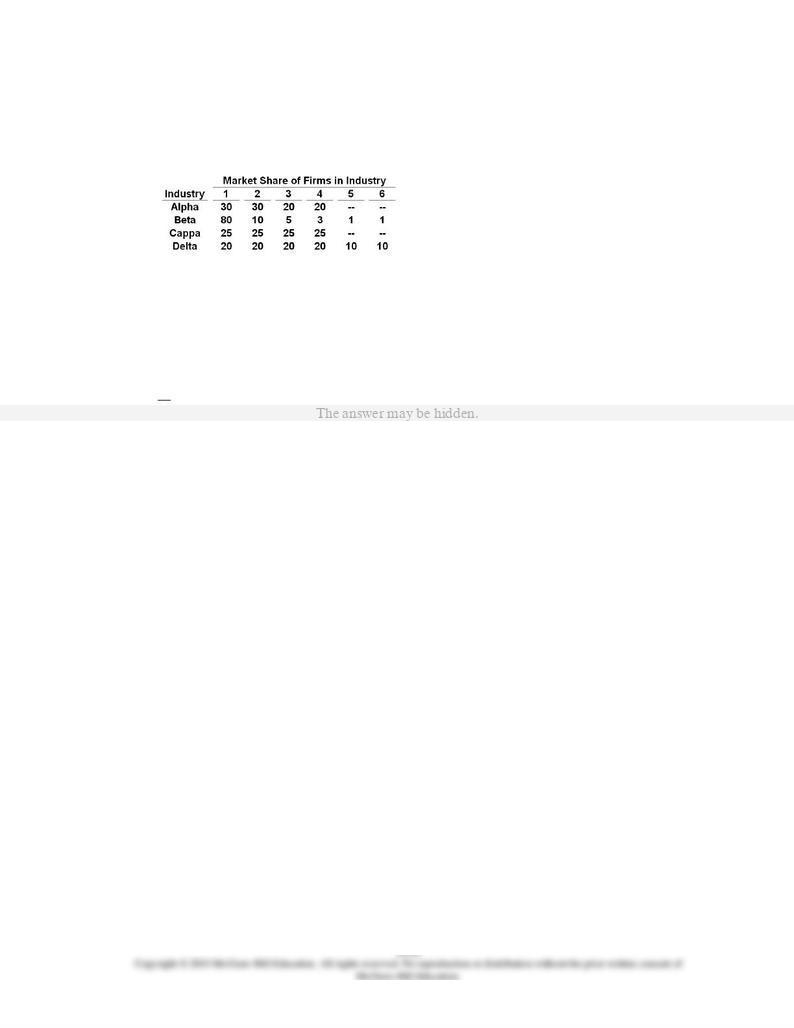
Chapter 19 Antitrust Policy and Regulation Answer Key
Multiple Choice Questions
1.
All of the following can file antitrust charges under the Sherman Act except:
AACSB: Reflective Thinking
Accessibility: Keyboard Navigation
Blooms: Remember
Difficulty: 1 Easy
Learning Objective: 19-01 List and explain the core elements of the major antitrust (antimonopoly) laws in the United
States.
Topic: Antitrust laws
2.
Movie producers A, B, and C secretly meet and agree to release their summer blockbuster
films in sequence, rather than at the same time. The U.S. Justice Department learns of the
agreement and files an antitrust suit. The federal government would most likely file
charges under the:
AACSB: Reflective Thinking
Accessibility: Keyboard Navigation
Blooms: Apply
Difficulty: 2 Medium
Learning Objective: 19-01 List and explain the core elements of the major antitrust (antimonopoly) laws in the United
States.
Topic: Antitrust laws

3.
Which of the following is least likely to violate the Sherman Act or the Clayton Act?
AACSB: Reflective Thinking
Accessibility: Keyboard Navigation
Blooms: Apply
Difficulty: 2 Medium
Learning Objective: 19-01 List and explain the core elements of the major antitrust (antimonopoly) laws in the United
States.
Topic: Antitrust laws
4.
The Sherman Act was designed to:
AACSB: Reflective Thinking
Accessibility: Keyboard Navigation
Blooms: Understand
Difficulty: 2 Medium
Learning Objective: 19-01 List and explain the core elements of the major antitrust (antimonopoly) laws in the United
States.
Topic: Antitrust laws

5.
Which one of the following acts declared "[e]very contract, combination . . . or conspiracy,
in restraint of trade or commerce among the several states . . . to be illegal"?
AACSB: Analytic
Accessibility: Keyboard Navigation
Blooms: Remember
Difficulty: 1 Easy
Learning Objective: 19-01 List and explain the core elements of the major antitrust (antimonopoly) laws in the United
States.
Topic: Antitrust laws
6.
The Clayton Act of 1914:
AACSB: Analytic
Accessibility: Keyboard Navigation
Blooms: Remember
Difficulty: 1 Easy
Learning Objective: 19-01 List and explain the core elements of the major antitrust (antimonopoly) laws in the United
States.
Topic: Antitrust laws

7.
A function of the Federal Trade Commission is to:
AACSB: Reflective Thinking
Accessibility: Keyboard Navigation
Blooms: Remember
Difficulty: 1 Easy
Learning Objective: 19-01 List and explain the core elements of the major antitrust (antimonopoly) laws in the United
States.
Topic: Antitrust laws
8.
Which one of the following is
not
prohibited by the original Clayton Act?
AACSB: Reflective Thinking
Accessibility: Keyboard Navigation
Blooms: Remember
Difficulty: 1 Easy
Learning Objective: 19-01 List and explain the core elements of the major antitrust (antimonopoly) laws in the United
States.
Topic: Antitrust laws
9.
Which of the following is directly illegal under the Sherman Act?
AACSB: Reflective Thinking
Accessibility: Keyboard Navigation

Blooms: Remember
Difficulty: 1 Easy
Learning Objective: 19-01 List and explain the core elements of the major antitrust (antimonopoly) laws in the United
States.
Topic: Antitrust laws
10.
Tying contracts are illegal under the:
AACSB: Analytic
Accessibility: Keyboard Navigation
Blooms: Remember
Difficulty: 1 Easy
Learning Objective: 19-01 List and explain the core elements of the major antitrust (antimonopoly) laws in the United
States.
Topic: Antitrust laws
11.
Suppose Slow Ketchup requires that, as a condition of purchase, all restaurants using its
product must buy and make available its new sales product. This arrangement is an
example of:
AACSB: Reflective Thinking
Accessibility: Keyboard Navigation
Blooms: Apply
Difficulty: 2 Medium
Learning Objective: 19-01 List and explain the core elements of the major antitrust (antimonopoly) laws in the United
States.
Topic: Antitrust laws

12.
Which of the following laws prohibited mergers by stock acquisition if the effect was to
lessen competition?
AACSB: Reflective Thinking
Accessibility: Keyboard Navigation
Blooms: Remember
Difficulty: 1 Easy
Learning Objective: 19-01 List and explain the core elements of the major antitrust (antimonopoly) laws in the United
States.
Topic: Antitrust laws
13.
Which of the following gave the Federal Trade Commission responsibility to protect the
public against false and misleading advertising?
AACSB: Reflective Thinking
Accessibility: Keyboard Navigation
Blooms: Remember
Difficulty: 1 Easy
Learning Objective: 19-01 List and explain the core elements of the major antitrust (antimonopoly) laws in the United
States.
Topic: Antitrust laws

14.
Which of the following amended the Clayton Act's prohibition against mergers that
substantially lessen competition?
AACSB: Reflective Thinking
Accessibility: Keyboard Navigation
Blooms: Remember
Difficulty: 1 Easy
Learning Objective: 19-01 List and explain the core elements of the major antitrust (antimonopoly) laws in the United
States.
Topic: Antitrust laws
15.
Which of the following made monopoly and restraints of trade criminal offenses against
the federal government?
AACSB: Reflective Thinking
Accessibility: Keyboard Navigation
Blooms: Remember
Difficulty: 1 Easy
Learning Objective: 19-01 List and explain the core elements of the major antitrust (antimonopoly) laws in the United
States.
Topic: Antitrust laws

16.
Tying agreements:
AACSB: Analytic
Accessibility: Keyboard Navigation
Blooms: Remember
Difficulty: 1 Easy
Learning Objective: 19-01 List and explain the core elements of the major antitrust (antimonopoly) laws in the United
States.
Topic: Antitrust laws
17.
Responsibility for enforcing the antitrust laws rests:
AACSB: Reflective Thinking
Accessibility: Keyboard Navigation
Blooms: Remember
Difficulty: 1 Easy
Learning Objective: 19-01 List and explain the core elements of the major antitrust (antimonopoly) laws in the United
States.
Topic: Antitrust laws
18.
The Celler-Kefauver Act of 1950:
AACSB: Reflective Thinking
Accessibility: Keyboard Navigation

Blooms: Remember
Difficulty: 1 Easy
Learning Objective: 19-01 List and explain the core elements of the major antitrust (antimonopoly) laws in the United
States.
Topic: Antitrust laws
19.
The Celler-Kefauver Act of 1950:
AACSB: Reflective Thinking
Accessibility: Keyboard Navigation
Blooms: Remember
Difficulty: 1 Easy
Learning Objective: 19-01 List and explain the core elements of the major antitrust (antimonopoly) laws in the United
States.
Topic: Antitrust laws
20.
Suppose the courts declare that XYZ Corporation violated the antitrust laws and as a
result the ABC Corporation lost $100 million of profits. XYZ Corporation will have to pay
ABC Corporation a monetary award of:
AACSB: Analytic
Accessibility: Keyboard Navigation
Blooms: Apply
Difficulty: 2 Medium
Learning Objective: 19-01 List and explain the core elements of the major antitrust (antimonopoly) laws in the United
States.
Topic: Antitrust laws

21.
Price-fixing:
AACSB: Reflective Thinking
Accessibility: Keyboard Navigation
Blooms: Remember
Difficulty: 1 Easy
Learning Objective: 19-01 List and explain the core elements of the major antitrust (antimonopoly) laws in the United
States.
Topic: Antitrust laws
22.
The antitrust laws are based on the:
AACSB: Reflective Thinking
Accessibility: Keyboard Navigation
Blooms: Understand
Difficulty: 2 Medium
Learning Objective: 19-01 List and explain the core elements of the major antitrust (antimonopoly) laws in the United
States.
Topic: Antitrust laws
23.
The Sherman Act:
AACSB: Reflective Thinking

Accessibility: Keyboard Navigation
Blooms: Remember
Difficulty: 1 Easy
Learning Objective: 19-01 List and explain the core elements of the major antitrust (antimonopoly) laws in the United
States.
Topic: Antitrust laws
24.
The main purpose of the antitrust laws is:
AACSB: Reflective Thinking
Accessibility: Keyboard Navigation
Blooms: Understand
Difficulty: 2 Medium
Learning Objective: 19-01 List and explain the core elements of the major antitrust (antimonopoly) laws in the United
States.
Topic: Antitrust laws
25.
The antitrust laws are enforced by the:
AACSB: Reflective Thinking
Accessibility: Keyboard Navigation
Blooms: Remember
Difficulty: 1 Easy
Learning Objective: 19-01 List and explain the core elements of the major antitrust (antimonopoly) laws in the United
States.
Topic: Antitrust laws

26.
Interlocking directorates are:
AACSB: Reflective Thinking
Accessibility: Keyboard Navigation
Blooms: Remember
Difficulty: 1 Easy
Learning Objective: 19-01 List and explain the core elements of the major antitrust (antimonopoly) laws in the United
States.
Topic: Antitrust laws
27.
The Federal Trade Commission:
AACSB: Reflective Thinking
Accessibility: Keyboard Navigation
Blooms: Remember
Difficulty: 1 Easy
Learning Objective: 19-01 List and explain the core elements of the major antitrust (antimonopoly) laws in the United
States.
Topic: Antitrust laws
28.
The government was successful in gaining an antitrust conviction in the:
AACSB: Reflective Thinking
Accessibility: Keyboard Navigation

Blooms: Apply
Difficulty: 2 Medium
Learning Objective: 19-01 List and explain the core elements of the major antitrust (antimonopoly) laws in the United
States.
Learning Objective: 19-02 Describe some of the key issues relating to the interpretation and application of antitrust laws.
Topic: Antitrust laws
Topic: Antitrust policy: issues and impacts
29.
In which of the following cases did the final court decision result in a breakup of the firm
into competing businesses?
AACSB: Reflective Thinking
Accessibility: Keyboard Navigation
Blooms: Apply
Difficulty: 2 Medium
Learning Objective: 19-02 Describe some of the key issues relating to the interpretation and application of antitrust laws.
Topic: Antitrust policy: issues and impacts
30.
In which of the following cases was the firm found
not
guilty
of violating the Sherman
Act?
AACSB: Reflective Thinking
Accessibility: Keyboard Navigation
Blooms: Apply
Difficulty: 2 Medium
Learning Objective: 19-02 Describe some of the key issues relating to the interpretation and application of antitrust laws.
Topic: Antitrust policy: issues and impacts

31.
In the Microsoft antitrust case, the federal government said in essence that:
AACSB: Reflective Thinking
Accessibility: Keyboard Navigation
Blooms: Apply
Difficulty: 2 Medium
Learning Objective: 19-02 Describe some of the key issues relating to the interpretation and application of antitrust laws.
Topic: Antitrust policy: issues and impacts
32.
In which of the following sets of antitrust cases did the government gain convictions?
AACSB: Reflective Thinking
Accessibility: Keyboard Navigation
Blooms: Understand
Difficulty: 2 Medium
Learning Objective: 19-02 Describe some of the key issues relating to the interpretation and application of antitrust laws.
Topic: Antitrust policy: issues and impacts

33.
In which of the following pairs of antitrust cases did the firms prevail against the antitrust
charges leveled against them?
AACSB: Reflective Thinking
Accessibility: Keyboard Navigation
Blooms: Apply
Difficulty: 2 Medium
Learning Objective: 19-02 Describe some of the key issues relating to the interpretation and application of antitrust laws.
Topic: Antitrust policy: issues and impacts
34.
The "rule of reason" indicated that:
AACSB: Analytic
Accessibility: Keyboard Navigation
Blooms: Remember
Difficulty: 1 Easy
Learning Objective: 19-02 Describe some of the key issues relating to the interpretation and application of antitrust laws.
Topic: Antitrust policy: issues and impacts

35.
In the Alcoa case of 1945, the courts held that:
AACSB: Reflective Thinking
Accessibility: Keyboard Navigation
Blooms: Apply
Difficulty: 2 Medium
Learning Objective: 19-02 Describe some of the key issues relating to the interpretation and application of antitrust laws.
Topic: Antitrust policy: issues and impacts
36.
The basic issue in the DuPont cellophane case was:
AACSB: Reflective Thinking
Accessibility: Keyboard Navigation
Blooms: Apply
Difficulty: 2 Medium
Learning Objective: 19-02 Describe some of the key issues relating to the interpretation and application of antitrust laws.
Topic: Antitrust policy: issues and impacts

37.
Suppose a court rules that the ABC Corporation is in violation of the antitrust laws
because it produces 70 percent of the output of its industry. This decision is consistent
with the:
AACSB: Reflective Thinking
Accessibility: Keyboard Navigation
Blooms: Understand
Difficulty: 2 Medium
Learning Objective: 19-02 Describe some of the key issues relating to the interpretation and application of antitrust laws.
Topic: Antitrust policy: issues and impacts
38.
The Alcoa case:
AACSB: Reflective Thinking
Accessibility: Keyboard Navigation
Blooms: Apply
Difficulty: 2 Medium
Learning Objective: 19-02 Describe some of the key issues relating to the interpretation and application of antitrust laws.
Topic: Antitrust policy: issues and impacts

39.
In the U.S. Steel case of 1920, the courts held that:
AACSB: Reflective Thinking
Accessibility: Keyboard Navigation
Blooms: Apply
Difficulty: 2 Medium
Learning Objective: 19-02 Describe some of the key issues relating to the interpretation and application of antitrust laws.
Topic: Antitrust policy: issues and impacts
40.
Restructuring of a major industry resulted from the:
AACSB: Reflective Thinking
Accessibility: Keyboard Navigation
Blooms: Apply
Difficulty: 2 Medium
Learning Objective: 19-02 Describe some of the key issues relating to the interpretation and application of antitrust laws.
Topic: Antitrust policy: issues and impacts

41.
In the U.S. Steel case, the court ruled that:
AACSB: Reflective Thinking
Accessibility: Keyboard Navigation
Blooms: Apply
Difficulty: 2 Medium
Learning Objective: 19-02 Describe some of the key issues relating to the interpretation and application of antitrust laws.
Topic: Antitrust policy: issues and impacts
42.
The decision in the U.S. Steel case:
AACSB: Reflective Thinking
Accessibility: Keyboard Navigation
Blooms: Apply
Difficulty: 2 Medium
Learning Objective: 19-02 Describe some of the key issues relating to the interpretation and application of antitrust laws.
Topic: Antitrust policy: issues and impacts

43.
Which of the following is most likely to increase the Herfindahl index of a particular
industry?
AACSB: Reflective Thinking
Accessibility: Keyboard Navigation
Blooms: Apply
Difficulty: 2 Medium
Learning Objective: 19-02 Describe some of the key issues relating to the interpretation and application of antitrust laws.
Topic: Antitrust policy: issues and impacts
44.
Which of the following findings would be the most likely to lead the U.S. Justice
Department to block a corporate merger under terms of the Clayton Act?
AACSB: Reflective Thinking
Accessibility: Keyboard Navigation
Blooms: Apply
Difficulty: 2 Medium
Learning Objective: 19-02 Describe some of the key issues relating to the interpretation and application of antitrust laws.
Topic: Antitrust policy: issues and impacts

45.
A merger between an automobile manufacturer and a maker of automobile tires is an
example of a:
AACSB: Reflective Thinking
Accessibility: Keyboard Navigation
Blooms: Apply
Difficulty: 2 Medium
Learning Objective: 19-02 Describe some of the key issues relating to the interpretation and application of antitrust laws.
Topic: Antitrust policy: issues and impacts
46.
Which one of the following is most likely to increase the Herfindahl index of a particular
industry?
AACSB: Reflective Thinking
Accessibility: Keyboard Navigation
Blooms: Understand
Difficulty: 2 Medium
Learning Objective: 19-02 Describe some of the key issues relating to the interpretation and application of antitrust laws.
Topic: Antitrust policy: issues and impacts

47.
A merger between a maker of household detergents and a fast-food chain would be an
example of:
AACSB: Reflective Thinking
Accessibility: Keyboard Navigation
Blooms: Apply
Difficulty: 2 Medium
Learning Objective: 19-02 Describe some of the key issues relating to the interpretation and application of antitrust laws.
Topic: Antitrust policy: issues and impacts
48.
A conglomerate merger:
AACSB: Reflective Thinking
Accessibility: Keyboard Navigation
Blooms: Understand
Difficulty: 2 Medium
Learning Objective: 19-02 Describe some of the key issues relating to the interpretation and application of antitrust laws.
Topic: Antitrust policy: issues and impacts

49.
A vertical merger involves a combining of one or more firms:
AACSB: Analytic
Accessibility: Keyboard Navigation
Blooms: Remember
Difficulty: 1 Easy
Learning Objective: 19-02 Describe some of the key issues relating to the interpretation and application of antitrust laws.
Topic: Antitrust policy: issues and impacts
50.
A merger of several firms operating in different industries—for example, a trucking
company, a fast-food chain, and a brokerage house—is called:
AACSB: Analytic
Accessibility: Keyboard Navigation
Blooms: Remember
Difficulty: 1 Easy
Learning Objective: 19-02 Describe some of the key issues relating to the interpretation and application of antitrust laws.
Topic: Antitrust policy: issues and impacts

51.
Structuralists take the position that:
AACSB: Analytic
Accessibility: Keyboard Navigation
Blooms: Remember
Difficulty: 1 Easy
Learning Objective: 19-02 Describe some of the key issues relating to the interpretation and application of antitrust laws.
Topic: Antitrust policy: issues and impacts
52.
Behavioralists believe that:
AACSB: Analytic
Accessibility: Keyboard Navigation
Blooms: Remember
Difficulty: 1 Easy
Learning Objective: 19-02 Describe some of the key issues relating to the interpretation and application of antitrust laws.
Topic: Antitrust policy: issues and impacts

53.
A firm charged with monopolizing a market is less likely to be convicted if:
AACSB: Reflective Thinking
Accessibility: Keyboard Navigation
Blooms: Understand
Difficulty: 2 Medium
Learning Objective: 19-02 Describe some of the key issues relating to the interpretation and application of antitrust laws.
Topic: Antitrust policy: issues and impacts
54.
Price-fixing is considered to be a per se violation of the antitrust laws because:
AACSB: Reflective Thinking
Accessibility: Keyboard Navigation
Blooms: Understand
Difficulty: 2 Medium
Learning Objective: 19-02 Describe some of the key issues relating to the interpretation and application of antitrust laws.
Topic: Antitrust policy: issues and impacts
55.
Conspiracies to fix prices are:
AACSB: Reflective Thinking
Accessibility: Keyboard Navigation
Blooms: Remember

Difficulty: 1 Easy
Learning Objective: 19-02 Describe some of the key issues relating to the interpretation and application of antitrust laws.
Topic: Antitrust policy: issues and impacts
56.
Which of the following is
correct
?
AACSB: Reflective Thinking
Accessibility: Keyboard Navigation
Blooms: Understand
Difficulty: 2 Medium
Learning Objective: 19-02 Describe some of the key issues relating to the interpretation and application of antitrust laws.
Topic: Antitrust policy: issues and impacts
57.
Which one of the following is
not
correct
?
AACSB: Reflective Thinking
Accessibility: Keyboard Navigation
Blooms: Remember
Difficulty: 1 Easy
Learning Objective: 19-02 Describe some of the key issues relating to the interpretation and application of antitrust laws.
Topic: Antitrust policy: issues and impacts

58.
Antitrust authorities are
least
likely to take action against:
AACSB: Reflective Thinking
Accessibility: Keyboard Navigation
Blooms: Understand
Difficulty: 2 Medium
Learning Objective: 19-02 Describe some of the key issues relating to the interpretation and application of antitrust laws.
Topic: Antitrust policy: issues and impacts
59.
Answer the question on the basis of the following table showing market shares of firms in
hypothetical industries. Assume these are distinct industries with no buyer-seller
B.
100.
C.
100,000.
AACSB: Analytic
Blooms: Apply
Difficulty: 2 Medium
Learning Objective: 19-02 Describe some of the key issues relating to the interpretation and application of antitrust laws.
Topic: Antitrust policy: issues and impacts
Type: Table

60.
Answer the question on the basis of the following table showing market shares of firms in
hypothetical industries. Assume these are distinct industries with no buyer-seller
relationships or competition among them.
Refer to the table. The industry with the greatest market power as measured by the
Herfindahl index is:
A.
Alpha.
B.
Beta.
C.
Cappa.
AACSB: Analytic
Blooms: Apply
Difficulty: 2 Medium
Learning Objective: 19-02 Describe some of the key issues relating to the interpretation and application of antitrust laws.
Topic: Antitrust policy: issues and impacts
Type: Table

61.
Answer the question on the basis of the following table showing market shares of firms in
hypothetical industries. Assume these are distinct industries with no buyer-seller
relationships or competition among them.
Refer to the table. A merger between Firm 2 and Firm 3 in Alpha would be a:
AACSB: Reflective Thinking
Blooms: Apply
Difficulty: 2 Medium
Learning Objective: 19-02 Describe some of the key issues relating to the interpretation and application of antitrust laws.
Topic: Antitrust policy: issues and impacts
Type: Table

62.
Answer the question on the basis of the following table showing market shares of firms in
hypothetical industries. Assume these are distinct industries with no buyer-seller
relationships or competition among them.
Refer to the table. A merger between Firm 1 in Alpha and Firm 2 in Delta would be a:
AACSB: Reflective Thinking
Blooms: Apply
Difficulty: 2 Medium
Learning Objective: 19-02 Describe some of the key issues relating to the interpretation and application of antitrust laws.
Topic: Antitrust policy: issues and impacts
Type: Table

63.
Answer the question on the basis of the following table showing market shares of firms in
hypothetical industries. Assume these are distinct industries with no buyer-seller
relationships or competition among them.
Refer to the table. The government would likely challenge a merger between:
A.
Firm 1 in Alpha and Firm 6 in Delta.
B.
Firms 3 and 4 in Beta.
C.
Firms 1 and 2 in Cappa.
AACSB: Reflective Thinking
Blooms: Apply
Difficulty: 2 Medium
Learning Objective: 19-02 Describe some of the key issues relating to the interpretation and application of antitrust laws.
Topic: Antitrust policy: issues and impacts
Type: Table

64.
Answer the question on the basis of the following table showing market shares of firms in
hypothetical industries. Assume these are distinct industries with no buyer-seller
relationships or competition among them.
Refer to the table. A structuralist would most likely assert that there is a violation of
antitrust law in which industry?
A.
Alpha.
B.
Beta.
C.
Cappa.
AACSB: Reflective Thinking
Blooms: Apply
Difficulty: 2 Medium
Learning Objective: 19-02 Describe some of the key issues relating to the interpretation and application of antitrust laws.
Topic: Antitrust policy: issues and impacts
Type: Table
65.
Suppose the firms in a five-firm industry have market shares of 30, 30, 20, 10, and 10
percent, respectively. The Herfindahl index for the industry is:
C.
90.
AACSB: Analytic
Accessibility: Keyboard Navigation
Blooms: Apply
Difficulty: 2 Medium
Learning Objective: 19-02 Describe some of the key issues relating to the interpretation and application of antitrust laws.
Topic: Antitrust policy: issues and impacts

66.
Suppose that two firms in an industry with a Herfindahl index of 5,000 announce a merger.
The U.S. Justice Department concludes the merger will boost the index to 5,500. The
antitrust authorities will most likely:
AACSB: Analytic
Accessibility: Keyboard Navigation
Blooms: Apply
Difficulty: 2 Medium
Learning Objective: 19-02 Describe some of the key issues relating to the interpretation and application of antitrust laws.
Topic: Antitrust policy: issues and impacts
67.
Suppose that two firms in an industry that has a Herfindahl index of 1,000 announce a
merger. The U.S. Justice Department concludes the merger will boost the index to 1,050.
The antitrust authorities will most likely:
AACSB: Analytic
Accessibility: Keyboard Navigation
Blooms: Apply
Difficulty: 2 Medium
Learning Objective: 19-02 Describe some of the key issues relating to the interpretation and application of antitrust laws.
Topic: Antitrust policy: issues and impacts

68.
The view that the antitrust laws should be enforced relatively leniently because of the
tendency for monopoly power to erode over time is known as the:
AACSB: Analytic
Accessibility: Keyboard Navigation
Blooms: Remember
Difficulty: 1 Easy
Learning Objective: 19-02 Describe some of the key issues relating to the interpretation and application of antitrust laws.
Topic: Antitrust policy: issues and impacts
69.
The view that the antitrust laws need to be strongly enforced to prevent illegal business
behaviors, monopolization of markets, and allocative inefficiency is known as the:
AACSB: Analytic
Accessibility: Keyboard Navigation
Blooms: Remember
Difficulty: 1 Easy
Learning Objective: 19-02 Describe some of the key issues relating to the interpretation and application of antitrust laws.
Topic: Antitrust policy: issues and impacts

70.
Economists who adhere to the laissez-faire antitrust perspective:
AACSB: Reflective Thinking
Accessibility: Keyboard Navigation
Blooms: Understand
Difficulty: 2 Medium
Learning Objective: 19-02 Describe some of the key issues relating to the interpretation and application of antitrust laws.
Topic: Antitrust policy: issues and impacts
71.
A firm is likely to be a natural monopoly:
AACSB: Reflective Thinking
Accessibility: Keyboard Navigation
Blooms: Understand
Difficulty: 2 Medium
Learning Objective: 19-03 Identify and explain the economic principles and difficulties relating to the setting of prices
(rates) charged by so-called natural monopolies.
Topic: Industrial regulation

72.
Which of the following is characteristic of a regulated natural monopoly?
AACSB: Analytic
Accessibility: Keyboard Navigation
Blooms: Understand
Difficulty: 2 Medium
Learning Objective: 19-03 Identify and explain the economic principles and difficulties relating to the setting of prices
(rates) charged by so-called natural monopolies.
Topic: Industrial regulation
73.
Suppose the transportation industry has been regulated for many years. Government now
proposes to deregulate the industry, only to find that firms in the industry oppose this
action. This is consistent with the:
AACSB: Reflective Thinking
Accessibility: Keyboard Navigation
Blooms: Apply
Difficulty: 2 Medium
Learning Objective: 19-03 Identify and explain the economic principles and difficulties relating to the setting of prices
(rates) charged by so-called natural monopolies.
Topic: Industrial regulation

74.
Using antitrust law to split up an
unregulated
natural monopoly into several competing
firms:
AACSB: Reflective Thinking
Accessibility: Keyboard Navigation
Blooms: Analyze
Difficulty: 3 Hard
Learning Objective: 19-03 Identify and explain the economic principles and difficulties relating to the setting of prices
(rates) charged by so-called natural monopolies.
Topic: Industrial regulation
75.
A major criticism of industrial regulation is that:
AACSB: Reflective Thinking
Accessibility: Keyboard Navigation
Blooms: Remember
Difficulty: 1 Easy
Learning Objective: 19-03 Identify and explain the economic principles and difficulties relating to the setting of prices
(rates) charged by so-called natural monopolies.
Topic: Industrial regulation

76.
Critics of the regulation of natural monopolies contend that:
AACSB: Reflective Thinking
Accessibility: Keyboard Navigation
Blooms: Remember
Difficulty: 1 Easy
Learning Objective: 19-03 Identify and explain the economic principles and difficulties relating to the setting of prices
(rates) charged by so-called natural monopolies.
Topic: Industrial regulation
77.
A market in which the entire demand for a good or service can be satisfied at the least
cost by a single firm is a:
AACSB: Analytic
Accessibility: Keyboard Navigation
Blooms: Remember
Difficulty: 1 Easy
Learning Objective: 19-03 Identify and explain the economic principles and difficulties relating to the setting of prices
(rates) charged by so-called natural monopolies.
Topic: Industrial regulation

78.
The legal cartel theory of regulation argues that:
AACSB: Reflective Thinking
Accessibility: Keyboard Navigation
Blooms: Remember
Difficulty: 1 Easy
Learning Objective: 19-03 Identify and explain the economic principles and difficulties relating to the setting of prices
(rates) charged by so-called natural monopolies.
Topic: Industrial regulation
79.
The public interest theory of industrial regulation contends that:
AACSB: Reflective Thinking
Accessibility: Keyboard Navigation
Blooms: Remember
Difficulty: 1 Easy
Learning Objective: 19-03 Identify and explain the economic principles and difficulties relating to the setting of prices
(rates) charged by so-called natural monopolies.
Topic: Industrial regulation

80.
Which one of the following is concerned with industrial regulation, as distinct from social
regulation?
AACSB: Analytic
Accessibility: Keyboard Navigation
Blooms: Remember
Difficulty: 1 Easy
Learning Objective: 19-03 Identify and explain the economic principles and difficulties relating to the setting of prices
(rates) charged by so-called natural monopolies.
Topic: Industrial regulation
81.
All of the following are regulatory commissions dealing with industrial regulation (as
distinct from social regulation) except the:
AACSB: Analytic
Accessibility: Keyboard Navigation
Blooms: Remember
Difficulty: 1 Easy
Learning Objective: 19-03 Identify and explain the economic principles and difficulties relating to the setting of prices
(rates) charged by so-called natural monopolies.
Topic: Industrial regulation

82.
Where there is natural monopoly, government is most likely to implement:
AACSB: Reflective Thinking
Accessibility: Keyboard Navigation
Blooms: Understand
Difficulty: 2 Medium
Learning Objective: 19-03 Identify and explain the economic principles and difficulties relating to the setting of prices
(rates) charged by so-called natural monopolies.
Topic: Industrial regulation
83.
The main purpose of industrial regulation is to:
AACSB: Reflective Thinking
Accessibility: Keyboard Navigation
Blooms: Understand
Difficulty: 2 Medium
Learning Objective: 19-03 Identify and explain the economic principles and difficulties relating to the setting of prices
(rates) charged by so-called natural monopolies.
Topic: Industrial regulation
84.
Critics of industrial regulation say that such regulation:
AACSB: Reflective Thinking
Accessibility: Keyboard Navigation

Blooms: Remember
Difficulty: 1 Easy
Learning Objective: 19-03 Identify and explain the economic principles and difficulties relating to the setting of prices
(rates) charged by so-called natural monopolies.
Topic: Industrial regulation
85.
Critics of industrial regulation say that such regulation:
AACSB: Reflective Thinking
Accessibility: Keyboard Navigation
Blooms: Remember
Difficulty: 1 Easy
Learning Objective: 19-03 Identify and explain the economic principles and difficulties relating to the setting of prices
(rates) charged by so-called natural monopolies.
Topic: Industrial regulation
86.
Overall, economists believe that deregulation of industries formerly subjected to industrial
regulation:
AACSB: Reflective Thinking
Accessibility: Keyboard Navigation
Blooms: Understand
Difficulty: 2 Medium
Learning Objective: 19-03 Identify and explain the economic principles and difficulties relating to the setting of prices
(rates) charged by so-called natural monopolies.
Topic: Industrial regulation

87.
The largest efficiency gains from deregulation have occurred in the:
AACSB: Analytic
Accessibility: Keyboard Navigation
Blooms: Remember
Difficulty: 1 Easy
Learning Objective: 19-03 Identify and explain the economic principles and difficulties relating to the setting of prices
(rates) charged by so-called natural monopolies.
Topic: Industrial regulation
88.
Social, as distinct from industrial, regulation is the major focus of the:
AACSB: Analytic
Accessibility: Keyboard Navigation
Blooms: Remember
Difficulty: 1 Easy
Learning Objective: 19-04 Discuss the nature of "social regulation;" its benefits and costs; and its optimal level.
Topic: Social regulation
89.
Defenders of social regulation point out that:
AACSB: Reflective Thinking
Accessibility: Keyboard Navigation

Blooms: Remember
Difficulty: 1 Easy
Learning Objective: 19-04 Discuss the nature of "social regulation;" its benefits and costs; and its optimal level.
Topic: Social regulation
90.
Social regulation differs from industrial regulation in that:
AACSB: Reflective Thinking
Accessibility: Keyboard Navigation
Blooms: Understand
Difficulty: 2 Medium
Learning Objective: 19-04 Discuss the nature of "social regulation;" its benefits and costs; and its optimal level.
Topic: Social regulation
91.
Critics of social regulation argue that it:
AACSB: Reflective Thinking
Accessibility: Keyboard Navigation
Blooms: Remember
Difficulty: 1 Easy
Learning Objective: 19-04 Discuss the nature of "social regulation;" its benefits and costs; and its optimal level.
Topic: Social regulation

92.
Which one of the following is concerned with social regulation?
AACSB: Analytic
Accessibility: Keyboard Navigation
Blooms: Remember
Difficulty: 1 Easy
Learning Objective: 19-04 Discuss the nature of "social regulation;" its benefits and costs; and its optimal level.
Topic: Social regulation
93.
The optimal amount of social regulation occurs where the marginal benefit of such
regulation:
AACSB: Reflective Thinking
Accessibility: Keyboard Navigation
Blooms: Understand
Difficulty: 2 Medium
Learning Objective: 19-04 Discuss the nature of "social regulation;" its benefits and costs; and its optimal level.
Topic: Social regulation

94.
Congressional representatives have called for extensive ergonomics regulations to reduce
strains and injuries from repetitive activities by workers. Such regulation, if passed, would
be a good example of:
AACSB: Reflective Thinking
Accessibility: Keyboard Navigation
Blooms: Apply
Difficulty: 2 Medium
Learning Objective: 19-04 Discuss the nature of "social regulation;" its benefits and costs; and its optimal level.
Topic: Social regulation
95.
(Consider This) The Consider This box "Of Catfish and Art (and Other Things in Common)"
lists examples of recent antitrust cases involving:
AACSB: Reflective Thinking
Accessibility: Keyboard Navigation
Blooms: Apply
Difficulty: 2 Medium
Learning Objective: 19-01 List and explain the core elements of the major antitrust (antimonopoly) laws in the United
States.
Learning Objective: 19-02 Describe some of the key issues relating to the interpretation and application of antitrust laws.
Topic: Antitrust laws
Topic: Antitrust policy: issues and impacts

96.
(Consider This) According to the Consider This box on catfish and art, which of the
following firms were convicted of price-fixing?
AACSB: Reflective Thinking
Accessibility: Keyboard Navigation
Blooms: Apply
Difficulty: 2 Medium
Learning Objective: 19-02 Describe some of the key issues relating to the interpretation and application of antitrust laws.
Topic: Antitrust policy: issues and impacts
97.
(Consider This) According to the Consider This box on catfish and art, which of the
following airlines in 2007 agreed to pay $300 million in fines for fixing fuel surcharges on
passenger tickets and cargo?
A.
Korean Air and British Airlines.
AACSB: Reflective Thinking
Accessibility: Keyboard Navigation
Blooms: Apply
Difficulty: 2 Medium
Learning Objective: 19-02 Describe some of the key issues relating to the interpretation and application of antitrust laws.
Topic: Antitrust policy: issues and impacts

98.
(Last Word) In 2001, Microsoft was found guilty of violating:
AACSB: Reflective Thinking
Accessibility: Keyboard Navigation
Blooms: Apply
Difficulty: 2 Medium
Learning Objective: 19-02 Describe some of the key issues relating to the interpretation and application of antitrust laws.
Topic: Antitrust policy: issues and impacts
99.
(Last Word) In 2001, Microsoft was found guilty of:
AACSB: Reflective Thinking
Accessibility: Keyboard Navigation
Blooms: Apply
Difficulty: 2 Medium
Learning Objective: 19-02 Describe some of the key issues relating to the interpretation and application of antitrust laws.
Topic: Antitrust policy: issues and impacts
100.
(Last Word) In 2001, a U.S. court of appeals tossed out an earlier U.S. district court order
that Microsoft:
AACSB: Reflective Thinking

Accessibility: Keyboard Navigation
Blooms: Apply
Difficulty: 2 Medium
Learning Objective: 19-02 Describe some of the key issues relating to the interpretation and application of antitrust laws.
Topic: Antitrust policy: issues and impacts
101.
(Last Word) The final settlement of the
United
States
v
.
Microsoft
case, in part:
AACSB: Reflective Thinking
Accessibility: Keyboard Navigation
Blooms: Apply
Difficulty: 2 Medium
Learning Objective: 19-02 Describe some of the key issues relating to the interpretation and application of antitrust laws.
Topic: Antitrust policy: issues and impacts
True / False Questions
102.
Price-fixing is illegal under Section 1 of the Sherman Act.
AACSB: Analytic
Accessibility: Keyboard Navigation
Blooms: Remember
Difficulty: 1 Easy
Learning Objective: 19-01 List and explain the core elements of the major antitrust (antimonopoly) laws in the United
States.
Topic: Antitrust laws

103.
Monopolization is illegal under Section 1 of the Sherman Act.
AACSB: Analytic
Accessibility: Keyboard Navigation
Blooms: Remember
Difficulty: 1 Easy
Learning Objective: 19-01 List and explain the core elements of the major antitrust (antimonopoly) laws in the United
States.
Topic: Antitrust laws
104.
The U.S. Justice Department, the Federal Trade Commission, state attorneys general, and
injured private parties can independently file charges against firms under the Sherman
Act.
AACSB: Reflective Thinking
Accessibility: Keyboard Navigation
Blooms: Remember
Difficulty: 1 Easy
Learning Objective: 19-01 List and explain the core elements of the major antitrust (antimonopoly) laws in the United
States.
Topic: Antitrust laws
105.
Anticompetitive mergers are illegal under provisions of the Clayton Act (as amended).
AACSB: Reflective Thinking
Accessibility: Keyboard Navigation
Blooms: Remember
Difficulty: 1 Easy
Learning Objective: 19-01 List and explain the core elements of the major antitrust (antimonopoly) laws in the United
States.
Learning Objective: 19-02 Describe some of the key issues relating to the interpretation and application of antitrust laws.
Topic: Antitrust laws
Topic: Antitrust policy: issues and impacts

106.
Proposed ergonomics regulations are an example of industrial regulation (rather than
social regulation).
AACSB: Reflective Thinking
Accessibility: Keyboard Navigation
Blooms: Apply
Difficulty: 2 Medium
Learning Objective: 19-04 Discuss the nature of "social regulation;" its benefits and costs; and its optimal level.
Topic: Social regulation
107.
Tying agreements are contracts by which retailers agree to charge the prices that
manufacturers set on branded goods.
AACSB: Analytic
Accessibility: Keyboard Navigation
Blooms: Remember
Difficulty: 1 Easy
Learning Objective: 19-01 List and explain the core elements of the major antitrust (antimonopoly) laws in the United
States.
Topic: Antitrust laws
108.
The Celler-Kefauver Act outlawed interlocking directorates.
AACSB: Analytic
Accessibility: Keyboard Navigation
Blooms: Remember
Difficulty: 1 Easy
Learning Objective: 19-01 List and explain the core elements of the major antitrust (antimonopoly) laws in the United
States.
Topic: Antitrust laws
109.
The regulation of natural monopolies has been criticized because it creates a tendency for
regulated firms to use too much labor and too little capital in the production process.
AACSB: Reflective Thinking

Accessibility: Keyboard Navigation
Blooms: Remember
Difficulty: 1 Easy
Learning Objective: 19-03 Identify and explain the economic principles and difficulties relating to the setting of prices
(rates) charged by so-called natural monopolies.
Topic: Industrial regulation
110.
The Celler-Kefauver Act made vertical mergers legal, provided each firm does not have
more than 30 percent of its relevant market.
AACSB: Analytic
Accessibility: Keyboard Navigation
Blooms: Remember
Difficulty: 1 Easy
Learning Objective: 19-01 List and explain the core elements of the major antitrust (antimonopoly) laws in the United
States.
Topic: Antitrust laws
Topic: Antitrust policy: issues and impacts
111.
The legal cartel theory indicates that, in any industry where market demand and the long-
run average total cost curve intersect close to the latter's minimum, government regulation
is mandatory and desirable.
AACSB: Analytic
Accessibility: Keyboard Navigation
Blooms: Remember
Difficulty: 1 Easy
Learning Objective: 19-03 Identify and explain the economic principles and difficulties relating to the setting of prices
(rates) charged by so-called natural monopolies.
Learning Objective: 19-04 Discuss the nature of "social regulation;" its benefits and costs; and its optimal level.
Topic: Industrial regulation
Topic: Social regulation
112.
The Consumer Product Safety Commission engages in social regulation, rather than
industrial regulation.
AACSB: Reflective Thinking
Accessibility: Keyboard Navigation

Blooms: Remember
Difficulty: 1 Easy
Learning Objective: 19-04 Discuss the nature of "social regulation;" its benefits and costs; and its optimal level.
Topic: Social regulation
113.
The Americans with Disabilities Act of 1990 is an example of industrial regulation.
AACSB: Reflective Thinking
Accessibility: Keyboard Navigation
Blooms: Remember
Difficulty: 1 Easy
Learning Objective: 19-04 Discuss the nature of "social regulation;" its benefits and costs; and its optimal level.
Topic: Social regulation